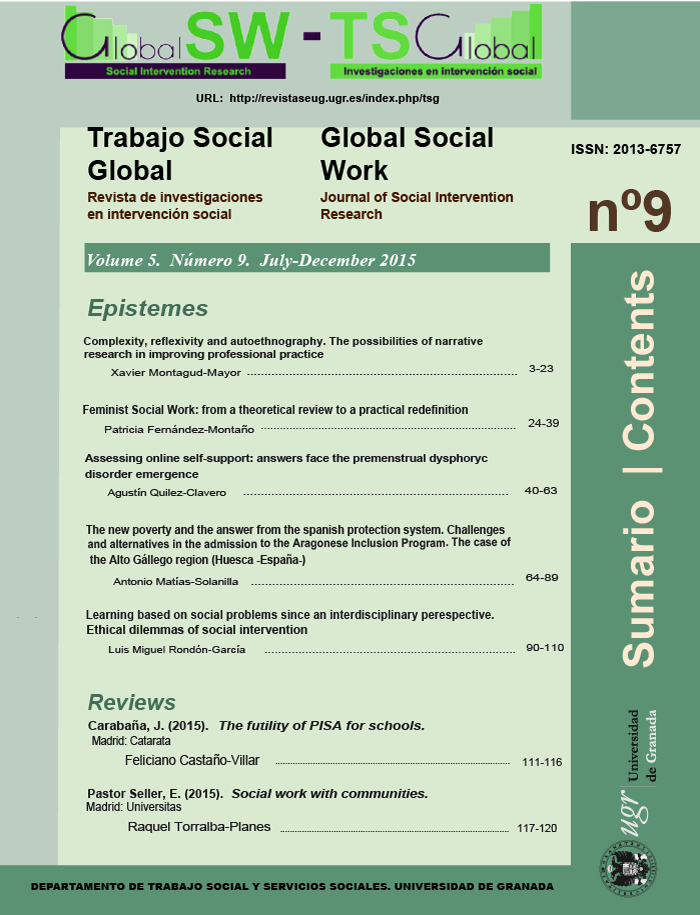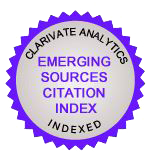ASSESSING ONLINE SELF-SUPPORT: ANSWERS FACE THE PREMENSTRUAL DYSPHORIC DISORDER EMERGENCE
DOI:
https://doi.org/10.30827/tsg-gsw.v5i9.3225Keywords:
Trabajo Social en línea, Trastorno Disfórico Premenstrual, Grupos de ayuda mutua, Análisis de contenido, Foros de Internet., Online Social Work Practice, Premenstrual dysphoric disorder, Self support groups, Content analyze, Internet forumsAbstract
Through the content analyze of two Internet self-support forums, spontaneously organized by women suffering Premenstrual dysphoric disorder, it is wanted The Social Work to attract its attention about the need of taking up professional initiatives generally to online Social Work practice and particularly to online self-support groups. This disorder is barely known. It causes serious consequences for the patients who have to tackle with frequent lack of understanding. This seriousness, often causes, affected are forced to drop out their jobs, or relationships like couples or friendships. Self-support becomes a relief to them who can express themselves on the Internet with people suffering the same situation. It has been a task for Social Work, supporting groups needing a convenient organization for obtaining an optimal empowerment. This challenge about Online Social Work practice is not common; consequently it is an interesting challenge for the Social Work of the beginning of the century.
Downloads
References
Arantón, L. (2014). Prescribir Links y Apps para empoderar a los pacientes. Enferm Dermatol. Vol 8(22), 44-49
American Psychiatric Association (2014). DSM-V: Manual diagnóstico y estadístico de trastornos mentales. México: Edición Panaméricana
Bardin, L. (2002). El análisis de contenido. Madrid: Ed. Akal.
Bonet, R. et al. (1994). Estrategias de grupo y SIDA: ayuda mutua. Revista de Psicología General y Aplicada Nº 47, 193-200
Cea, M.A. (2001). Metodología cuantitativa: estrategias y técnicas de investigación social. Madrid: Ed. Síntesis.
Chung, J.E. (2014). Social Networking in Online Support Groups of Health: How Online Social Networking Benefits Patients. Journal of Health Communication nº19, 639-659
Díaz, I. (2010) Ventajas e inconvenientes de la encuesta por Internet. 2010. Papers 97/1, 193-223
Elliot, H (2002) Premenstrual dysphoric disorder. A guide for the treating clinician. Consultado el 31 de agosto de 2015 de:
http://www.ncbi.nlm.nih.gov/pubmed/12063908
Escudero-Carretero et al. (2010) Fibromialgia: percepción de pacientes sobre su enfermedad y el sistema de salud. Estudio de investigación cualitativa. Reumatología clínica Nº 6, 16-22
Fernández-Pacheco, J.L. y Arriazu, R. (2012). Internet en el ámbito del Trabajo Social: formas emergentes de participación e intervención socio-comunitaria. Cuadernos de Trabajo Social nº 26, 149-158
Fuente et al. (2010). Internet y apoyo social: Sociabilidad online y ajuste psicosocial en la sociedad de la información. Rev Acción Psicológica, vol 7 nº 1, 9-15
Krippendorf, K. (1990) Metodología de análisis de contenido. Teoría y práctica. Barcelona: Paidós
Llopis, J. (2005). Redes sociales y Apoyo Social. Una aproximación a los Grupos de Autoayuda. Consultado el 22 de junio en: www.periferias.name
Mo, P.H, et Coulson, N (2013) Online support group use and psychological health for individuals living with HIV/AIDS. Patient Education and Counseling, 93, 426-432
Oliver, D.P. et al. (2015). Lessons learned from a secret facebook support group. Health&Social Work. Vol. 40 nº 2, 125-133
Rappaport, M. H. (2005) Quality-of-life Impairment in Depressive and Anxiety disorders. Am J Psychiatry 162, 1171-1178
Ródenas, S (1996). Grupos de ayuda mutua: una respuesta alternativa en la práctica del Trabajo Social. Rev.Alternativas nº4, 195-205
San Norberto, E. et al (2011). Calidad de la información disponible en internet sobre el aneurisma de aorta y su tratamiento endovascular. Rev Esp Cardiol. Nº 64(10), 869-875
Studd, J. (2012) Severe Premenstrual Syndrome and Bipolar Disorder: A Tragic Confusion. Menopause International, n18, 82-86
Soriano, M.A. (2008) Los grupos de autoapoyo para personas gays seropositivas. El estigma social imperante. Crítica nº 593, 51-54
Suriá, R. y Beléndez, M (2009). El efecto terapéutico de los grupos virtuales para pacientes con enfermedades crónicas. Boletín de Psicología nº 96, 35-46
______ (2010) De qué se habla en los foros de internet para problemas de salud? Análisis de contenido en función de la enfermedad y el sexo. Rev. Acción Psicológica. Vol 7. nº 1, 41-51
Van Spijker, B.A.J. et al. (2015). Online self-help for suicidal thoughts: 3-month follow-up results and participant evaluation. Internet interventions 2, 283-288
Viscarret, J.J (2007). Modelos y métodos de intervención en Trabajo Social. Madrid: Alianza.
Downloads
Published
How to Cite
Issue
Section
License
Authors publishing in this journal agree to the following terms:
- Authors retain their copyright. They guarantee to this journal the right to a first publication of the work submitted to initiate the editorial process.
- Authors know that their work is published under a Creative Commons License which allows others to share it, with a recognition of the work's authorship and its initial publication in this journal.
- Authors share with Global Social Work explotation rights of the work that has been published in this journal, authorizing the execution of a free reproduction, distribution and public communication. Authors know that their work will be stored on servers and reproduced in digital format for inclusion in institutional repositories and databases that will facilitates free access to the full text of the work.
- Authors may distribute the version of the work published in this journal (for example, to an institutional repository or publish it in a book), with the explicit acknowledgment of its initial publication in this journal.
Copyright on the texts published in Trabajo Social Global -Global Social Work, as well as editorial policy of the journal refering to self-file and deposit in institutional or thematic repositories, are identified in the database





















